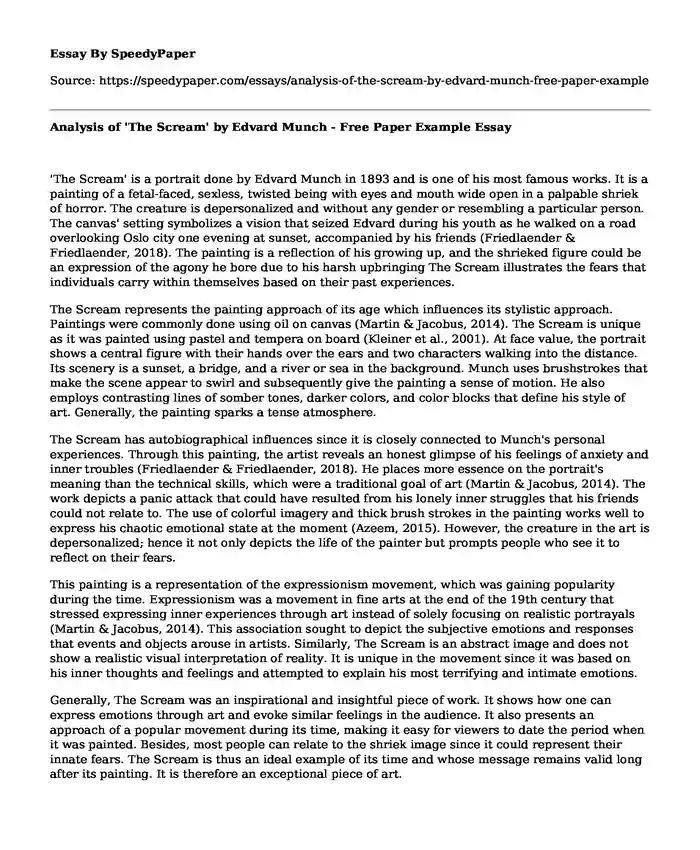
| Type of paper: | Essay |
| Categories: | Art |
| Pages: | 3 |
| Wordcount: | 801 words |
'The Scream' is a portrait done by Edvard Munch in 1893 and is one of his most famous works. It is a painting of a fetal-faced, sexless, twisted being with eyes and mouth wide open in a palpable shriek of horror. The creature is depersonalized and without any gender or resembling a particular person. The canvas' setting symbolizes a vision that seized Edvard during his youth as he walked on a road overlooking Oslo city one evening at sunset, accompanied by his friends (Friedlaender & Friedlaender, 2018). The painting is a reflection of his growing up, and the shrieked figure could be an expression of the agony he bore due to his harsh upbringing The Scream illustrates the fears that individuals carry within themselves based on their past experiences.
The Scream represents the painting approach of its age which influences its stylistic approach. Paintings were commonly done using oil on canvas (Martin & Jacobus, 2014). The Scream is unique as it was painted using pastel and tempera on board (Kleiner et al., 2001). At face value, the portrait shows a central figure with their hands over the ears and two characters walking into the distance. Its scenery is a sunset, a bridge, and a river or sea in the background. Munch uses brushstrokes that make the scene appear to swirl and subsequently give the painting a sense of motion. He also employs contrasting lines of somber tones, darker colors, and color blocks that define his style of art. Generally, the painting sparks a tense atmosphere.
The Scream has autobiographical influences since it is closely connected to Munch's personal experiences. Through this painting, the artist reveals an honest glimpse of his feelings of anxiety and inner troubles (Friedlaender & Friedlaender, 2018). He places more essence on the portrait's meaning than the technical skills, which were a traditional goal of art (Martin & Jacobus, 2014). The work depicts a panic attack that could have resulted from his lonely inner struggles that his friends could not relate to. The use of colorful imagery and thick brush strokes in the painting works well to express his chaotic emotional state at the moment (Azeem, 2015). However, the creature in the art is depersonalized; hence it not only depicts the life of the painter but prompts people who see it to reflect on their fears.
This painting is a representation of the expressionism movement, which was gaining popularity during the time. Expressionism was a movement in fine arts at the end of the 19th century that stressed expressing inner experiences through art instead of solely focusing on realistic portrayals (Martin & Jacobus, 2014). This association sought to depict the subjective emotions and responses that events and objects arouse in artists. Similarly, The Scream is an abstract image and does not show a realistic visual interpretation of reality. It is unique in the movement since it was based on his inner thoughts and feelings and attempted to explain his most terrifying and intimate emotions.
Generally, The Scream was an inspirational and insightful piece of work. It shows how one can express emotions through art and evoke similar feelings in the audience. It also presents an approach of a popular movement during its time, making it easy for viewers to date the period when it was painted. Besides, most people can relate to the shriek image since it could represent their innate fears. The Scream is thus an ideal example of its time and whose message remains valid long after its painting. It is therefore an exceptional piece of art.
Conclusion
Overall, The Scream is an ideal example of an expressionist work of art, showing how one can express their feelings through art. It reflects a movement of its time and the approaches taken by artists to produce such paintings. Besides, it depicts the artist's life as the portrait shows the inner feelings and emotions he harbored. People can also relate to it as it evokes them to reflect on their perceptions of uncertainty and fears within them. The painting’s relation with the painter’s life experiences enhanced my appreciation of art and served as a context that eased its interpretation. The Scream represents an exceptional piece of art that depicts both art history and culture.
References
Azeem, H. (2015). The art of Edvard Munch: a window onto a mind. BJPsych Advances, 21(1), 51-53. https://www2.le.ac.uk/departments/medicine/student-staff/staff-and-student-achievements/docs/APT2015Azeem513.pdf
Friedlaender, G. E., & Friedlaender, L. K. (2018). Edvard Munch and The Scream: A cry for help. Clinical orthopedics and related research, 476(2), 200. https://www.ncbi.nlm.nih.gov/pmc/articles/PMC6259715/
Martin, F. D., & Jacobus, L. (2014). Humanities through the Arts. McGraw-Hill Education.
Kleiner, F. S., Mamiya, C. J., & Tansey, R. G. (2001). Gardner's art through the ages. Fort Worth, TX: Harcourt College Publishers.
Cite this page
Analysis of 'The Scream' by Edvard Munch - Free Paper Example. (2023, Dec 03). Retrieved from https://speedypaper.net/essays/analysis-of-the-scream-by-edvard-munch-free-paper-example
Request Removal
If you are the original author of this essay and no longer wish to have it published on the SpeedyPaper website, please click below to request its removal:
- Comparison Essay Sample on Two Art Works - Burial at Arnans and The Maid
- MTV Conference, Description Essay Example
- Essay Sample on Iconic Chairs Presentation: Thonet Chair No. 14 and Michael Thonet Michael
- Free Essay - Louis Armstrong's Influence Over The World Of Music
- Suzie Cosmetics: IP Challenges of a Global Brand - Essay Sample
- Free Paper Example on Power to Heal
- Harmony of Expression: Unraveling Rhyme Patterns and Social Commentary in Mixtape Analysis - Free Essay
Popular categories




